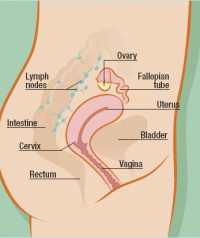
When ovarian cancer is diagnosed, it is vital to determine if the cancer has spread beyond the ovaries. Your treatment team may do more tests to determine if the cancer has spread. In addition, during surgery, certain additional steps should be performed to determine the extent of the disease. The process is called staging. Staging helps to determine the exact extent of your cancer and what treatment plan is best for you.
It is important that your surgery be performed by a gynecologic oncologist. Following surgery your cancer will be categorized into one of the following stages:


Stage I: The cancer is found in one or both ovaries. Cancer cells also may be found on the surface of the ovaries or in fluid collected from the abdomen.
Stage II: The cancer has spread from one or both ovaries to other tissues in the pelvis. For example, it may have spread to the fallopian tubes or to the uterus. Cancer cells may also be found in fluid collected from the abdomen.
Stage III: The cancer has spread outside the pelvis or nearby lymph nodes. Most commonly the cancer spreads to the omentum, diaphragm, intestine and the surface of the liver.
Stage IV: The cancer has spread to tissues outside the abdomen and pelvis. Most commonly the cancer has spread to the space around the lungs. If the cancer spreads inside the liver or spleen, it is considered stage IV.
The cancer will also be assigned a grade. Grade refers to how abnormal the cells appear under a microscope. Low grade tumors, also called grade 1, have features that resemble normal ovarian cells. In contrast, high grade tumors (grades 3 or 4) have a greatly altered microscopic appearance.